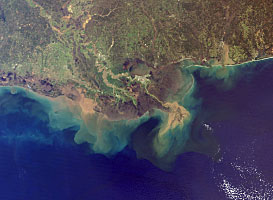5. Why is the ocean salty?
Rivers bring fresh water to a salty ocean. What causes this apparent paradox?
Water cycles through the atmosphere, ocean and land. This is called the hydrologic cycle. Water that evaporates from the ocean is fresh water. The salt stays in the ocean. That water can rain out of the atmosphere over the ocean or over land. If it rains out over land, it will enter a lake, river or ground water. Eventually it will end up in a river and go back to the ocean.
The fresh water that enters the ocean from rivers contains a very small amount of salt (less than 0.5 ppt). That small amount of salt is added to the ocean. Over a very long time, millions of years, the small amount of salt brought to the ocean by rivers each year eventually adds up to a large amount of salt. The oceans on Earth have existed for more than 4 billion years. Rivers have been bringing salt to the ocean for all that time.
 | A satellite image of the Mississippi River flowing into the Gulf of Mexico taken on March 5, 2001. Notice the brown water of the Mississippi mixing with the dark blue waters of the Gulf of Mexico. This image was taken two days after a rainstorm. The Atchafalaya River can be seen to the west of the Mississippi. Courtesy NASA Visible Earth Image Gallery http://visibleearth.nasa.gov/
(Click image to see a larger version) |
Salt leaves the ocean but it leaves very slowly. Salt spends a lot of time in the ocean before leaving. Salt leaves the ocean in several ways. One of the ways salt leaves the ocean is when water in an enclosed basin evaporates and forms evaporite deposits (see "Does table salt come from the ocean?").
The salinity of the ocean may have been different billions of years ago. However, for the last 400 million years, the salinity of the ocean has been very similar to the ocean today.
| 


